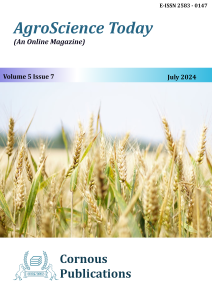Wheat (Triticum spp.) is one of the most important cereal crops globally and holds significant economic and nutritional value. It has been a cornerstone of human civilization, tracing its origins to the Fertile Crescent and evolving through centuries of cultivation and breeding. This paper examines the evolutionary journey and domestication of wheat, highlighting its transformation from wild grasses to modern cultivated varieties. Special attention is given to the historical and cultural significance of wheat in India, where it is the second most important cereal crop after rice. The Green Revolution marked a pivotal era in Indian wheat production, leading to significant yield improvements. Currently, wheat research in India focuses on addressing challenges such as climate change, disease resistance, and nutritional enhancement. By exploring these facets, the paper aims to provide a comprehensive understanding of wheat's evolution, domestication, and its current status in India, underscoring the crop's vital role in the nation's food security and agricultural landscape.
Nano biosensors have emerged as powerful analytical tools at the forefront of biosensing technology, offering unparalleled sensitivity and specificity in detecting biochemical substances at nanoscales. Comprising a bio-receptor sensing element and a transducer component, nano biosensors convert biological and biochemical signals into quantifiable physical signals using optical, electronic, thermal, or magnetic methods. The effectiveness of these sensors is contingent upon the precise attachment of the biological component to the transducer, ensuring stability and selectivity in analyte detection. By incorporating nanomaterials, nano biosensors enhance stability, sensitivity, and catalytic activity, revolutionizing biosensing capabilities. This article elucidates the working principles, classification, and applications of nano biosensors, emphasizing their pivotal role in diverse fields such as agriculture and biomedical diagnostics. From detecting soil pathogens to diagnosing severe diseases like cancer and diabetes, nano biosensors offer unprecedented opportunities for precise and efficient detection, marking a significant advancement in biosensor technology.
Pests and diseases cause significant crop losses every year, despite the fact that rice (Oryza sativa) is the staple food for more than half of the world's population. Paddy farmers use various pesticides to combat these issues, but their indiscriminate use has led to environmental and health problems, including insecticide resistance, pest resurgence, ecological imbalances and negative impacts on beneficial organisms and biodiversity. In India, heavy reliance on pesticides can make paddy farming uneconomical when pest control fails. In spite of the introduction of integrated pest management, chemical control is still the predominant method used by paddy farmers to manage pests. This trend has escalated significantly, leading to pesticide resurgence and resistance in insect pests such as leafhoppers brown plant hoppers, and rice leaf folder. Additionally, there is a risk of pesticide residues in grains. Therefore, it is crucial to encourage the use of less toxic chemicals, biopesticides, and practicable cultural methods while maintaining crop yields. This shift requires governmental support and the effective dissemination of scientific knowledge to farmers.
The Peninsular Zone characteristically has varied agro-climatic conditions. Growing wheat in this zone presents some unique challenges and characteristics. The crop suffers due to heat stress, temperature fluctuations, and variable rainfall. Typically, the tropical climate makes this region different from other wheat-growing regions in India. The soils of this zone are lateritic, red and black. Black soils (Regur soils) are moisture-retentive and fertile. Considering these constraints development of heat tolerant, disease resistant, high yielding and drought tolerant varieties have been bred to address the challenges. The discussion aims to inform policymakers, researchers, and farmers about strategic priorities and potential interventions to achieve long-term improvements in wheat farming in the Peninsular Zone.
Mrs. Rabia Begam, a 40 years old farm woman from Sarongdeopur village of Karimganj district has adopted Double Cropping System along with Integrated Farming System (IFS) by incorporating different components of crops and livestock. Earlier she was solely growing mono-crop like paddy by following traditional farming system and kept her land fallow till next season. After coming in touch with KVK, Karimganj and with the scientific intervention, she has started the practices of Double Cropping System i.e. “Paddy followed by Rajmah” with efficient utilization of resources and increases the income. For nutritional security and diet diversification, she established 200sqm Nutritional Gardens at her backyard to meet round the year vegetable requirements of her family. Later she integrated improved livestock and fishery component along with horticultural crops and provides additional income for her livelihood. Mrs. Rabia is now earning approximately Rs. 1,87,000.00 from an area of 1.5 ha by integrating different component (agriculture, horticulture, fish production, dairy farming, backyard poultry and duck farming) together which provide her stable income and improve living standard of her family. Mrs. Rabia determinations help her to adopt the innovative and sustainable farm practices within a short stretch of time and area which can be role model for the emerging Farming community. During the last three (2020-21 to 2022-23) years study it has shown that the income of Rabia Begum has increased around or more than double.
